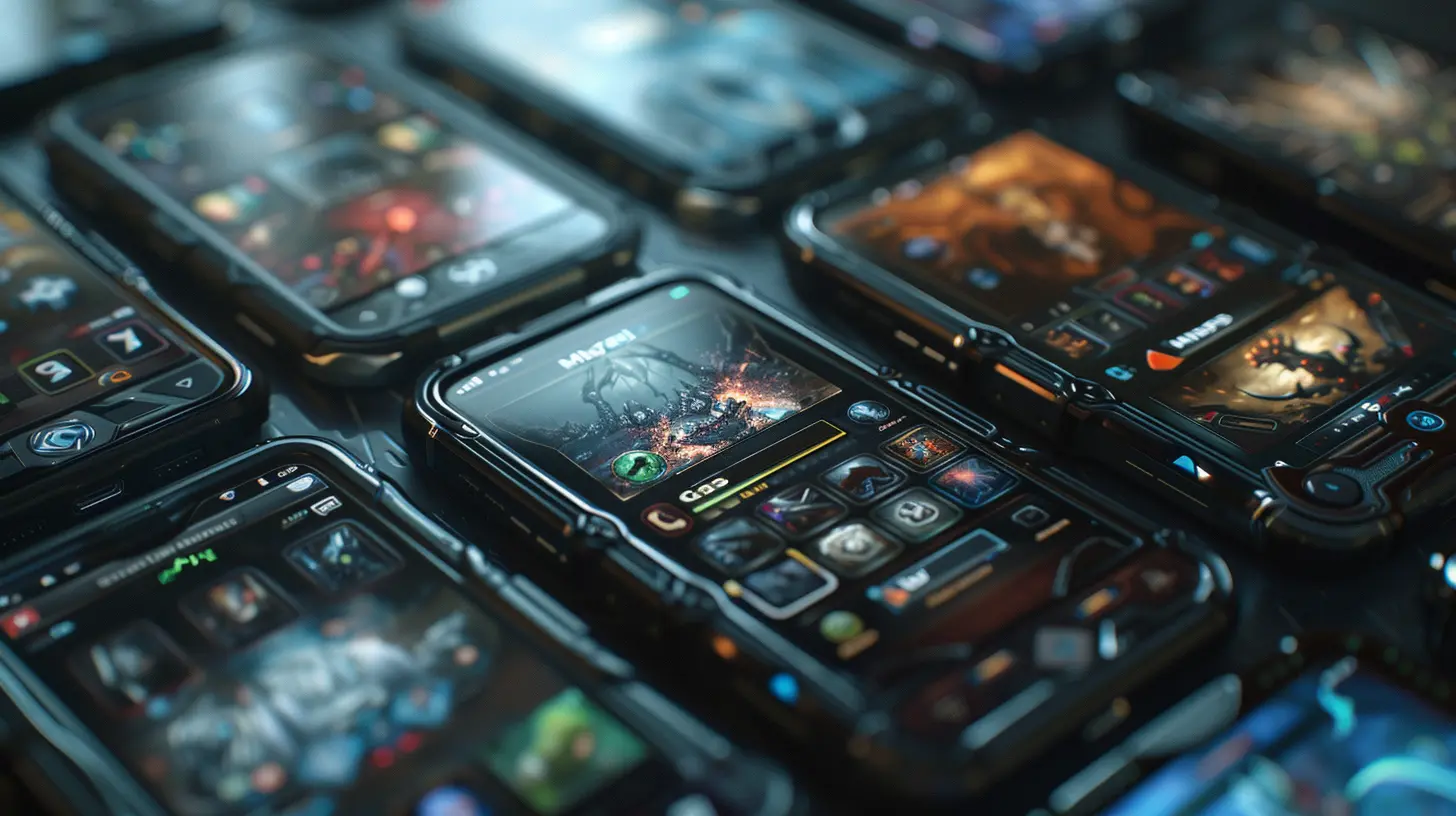Why Mobile Gaming is the Future of Gaming
14 November 2025
Let’s face it — we’re all glued to our phones these days. Whether it's scrolling through social media, checking messages, or catching up on news, our smartphones have become extensions of us. But there’s one thing we’re doing more than all that: gaming. Yep, mobile gaming is blowing up, and if you haven’t noticed, it’s not just Candy Crush anymore. It’s immersive, competitive, graphically intense — and it’s slowly but surely stealing the show from consoles and PCs.
So, why is mobile gaming the future of gaming? Buckle up, because we’re diving deep into that question. From tech advancements to social trends, we’re unpacking everything that makes mobile games the rising star of the gaming world.
Gaming in Your Pocket: Convenience is King
Let’s start with the most obvious reason — convenience. Your mobile phone is right there, literally in your pocket or hand 99% of the time. Unlike consoles or gaming PCs, which require specific setups, mobile games are ready to go whenever and wherever you are.Stuck in a boring meeting? Queue up a match in Clash Royale. Waiting for your latte? Knock out a quick level in Monument Valley. It's instant, it's easy, and it's right there in your palm.
No boot-up time. No hunting for the controller. No TV to fight over. Just tap and play.
Performance is Levelling Up
There was a time — not too long ago — when mobile games were clunky, pixelated, and lacking depth. Fast forward to today, and we've got mobile titles like Genshin Impact offering stunning visuals and enormous open-world gameplay. It’s legit console-quality stuff, optimized for the small screen.Why? Because smartphones are now mini powerhouses. Think about it: the average high-end smartphone has more processing power than some older gaming consoles. Plus, advancements in chips, RAM, and GPU capabilities mean that devs can push the boundaries like never before.
And let’s not forget cloud gaming. Services like Xbox Cloud Gaming and NVIDIA GeForce NOW are making it possible to stream AAA titles straight to your phone. No downloads needed. Just good internet and a Bluetooth controller, and boom — you’re playing Halo on your iPhone.
The Business Side: Money Talks
Here’s a little industry secret (okay, it's not really a secret): mobile gaming is making more money than console and PC gaming combined. Surprised? Most people are.According to data from Newzoo and Sensor Tower, mobile gaming made up over 50% of the global gaming revenue in recent years. And it's still growing. We're talking billions of dollars annually — yes, with a “B.”
Why? Microtransactions, baby. Games like PUBG Mobile and Call of Duty: Mobile are free to download but rake in the cash through skins, battle passes, and other in-game purchases. And people? We love customization. Spending a couple of bucks here and there feels small, but it adds up fast.
Democratizing Gaming for Everyone
One of the most beautiful things about mobile gaming is how inclusive it is. You don’t need to drop thousands on a gaming rig or even $500 on a console. If you have a smartphone — and most of the world does — you're ready to play.This accessibility has brought gaming to places and people that traditional gaming never reached. We're talking about people in developing countries, older adults, and casual gamers who’d never consider themselves “gamers” in the traditional sense. Mobile gaming has broadened the audience and blurred the lines of what a gamer looks like.
In other words, it’s not just for 14-year-olds in headsets anymore. It’s for your mom. Your co-workers. Your Uber driver. Even your grandma might be secretly crushing it in Candy Crush.
Social Gaming is Thriving
Remember when gaming used to be a lonely hobby? Those days are long gone.Mobile games are ridiculously social now — maybe even more than console or PC games. Think about it. With just one tap, you can invite friends to join a match, join a guild, or send a challenge. There’s seamless integration with social media, so sharing your high score or teaming up with friends has never been easier.
Games like Among Us, Clash of Clans, Fortnite Mobile, and even Pokémon GO have turned mobile devices into virtual hangout spots. In fact, during the pandemic, mobile games became one of the main ways people stayed connected. That’s huge.
Short Bursts of Fun: Designed for Modern Life
Let’s be real for a second: life is busy. Most of us don’t have the time to sink three hours into a single gaming session anymore. We’ve got work, school, chores, and maybe even a social life (gasp!).That’s where mobile games totally shine. They're built for short, satisfying bursts. Whether it’s five minutes or twenty, you can pick up where you left off without committing your whole evening. It’s like snacking instead of sitting down for a full-course meal.
Think Subway Surfers, Temple Run, or 8 Ball Pool. These aren't marathon games — they’re quick, addicting, and fit neatly into your daily routine. It’s gaming on the go, the same way streaming turned music and movies into something you could take anywhere.
Innovation is Happening Here First
It might sound crazy, but some of the biggest innovations in gaming are coming from mobile first. Why? Because the competition in the mobile space is fierce — developers are constantly pushing the envelope to stand out.We’re seeing AR (Augmented Reality) games like Pokémon GO that blend the real and digital worlds. We’ve got location-based games, gesture control, and even games that track your heart rate for fitness integration.
And let’s not ignore AI and adaptive gameplay, where mobile games adjust to your skills and play style in real-time. The tech is not only catching up to consoles — in some cases, it’s racing ahead.
Cross-Platform Play is the Norm Now
Once upon a time, mobile gamers stuck to mobile, and console gamers stuck to consoles. But that wall? It’s crumbling fast.More and more games are embracing cross-platform play. That means you could be on your phone, your buddy could be on their Xbox, and another friend could be on a PC — and you’re all playing the same game together. Titles like Fortnite, Minecraft, and Call of Duty: Mobile are leading the charge.
This is turning the idea of “platforms” into ancient history. The device matters less than the experience. If you’ve got the means, you’re in.
Gen Z and Millennials Are All In
Let’s not ignore the generational shift either. Younger players are growing up with mobile first, not consoles. Their first gaming experience probably wasn’t a Nintendo — it was an iPad.For Gen Z and younger millennials, mobile is the default. And you know what? That’s shaping the future of game development, marketing, and monetization strategies. Devs are now laser-focused on creating mobile-first hits that can go viral, be streamed, and become the next big trend.
In short, the future gamer is already a mobile gamer.
The Rise of Mobile Esports
Okay, this one's wild — mobile esports is a thing. A major thing.Tournaments for games like Mobile Legends: Bang Bang, PUBG Mobile, and Free Fire pull in millions of viewers. The prize money? Let’s just say it’s enough to make anyone want to start grinding.
It's not just the money, though. It's the legitimacy. These games are getting professional casters, analysts, huge venues, and massive fanbases. The world of mobile esports is exploding on a global scale, especially in Asia and South America.
And guess what? It’s only getting started.
5G and What’s Next
Let’s talk future-tech. With 5G rolling out more widely, mobile gaming is about to hit another level. We're talking ultra-low latency, faster downloads, and smoother gameplay — even in online multiplayer modes.That means more real-time battles, more cloud streaming, and better support for AR and VR experiences. It’s like adding rocket fuel to an already blazing fire.
Imagine a future where mobile games are so immersive, you forget you're not on a console. That’s not sci-fi — it’s happening.
Wrapping It Up: Mobile Gaming Is More Than a Trend
If you’re still thinking, “Nah, mobile games are just a casual thing,” it's time to rethink that whole mindset. Mobile gaming isn't just the future — it's already arrived.We're seeing a perfect storm of accessibility, tech evolution, social interactivity, and money (lots of money) all working together to make mobile gaming a permanent fixture in our lives. And with Gen Z leading the charge and 5G paving the way, there’s no slowing down.
So whether you're a hardcore gamer or someone who only plays during lunch breaks, remember this: the game is changing — and it fits in your pocket.
all images in this post were generated using AI tools
Category:
Mobile GamingAuthor:

Jerry Graham
Discussion
rate this article
1 comments
Lira Fuller
Great insights! Mobile gaming truly is a game-changer, making gaming accessible for everyone!
November 16, 2025 at 1:06 PM


